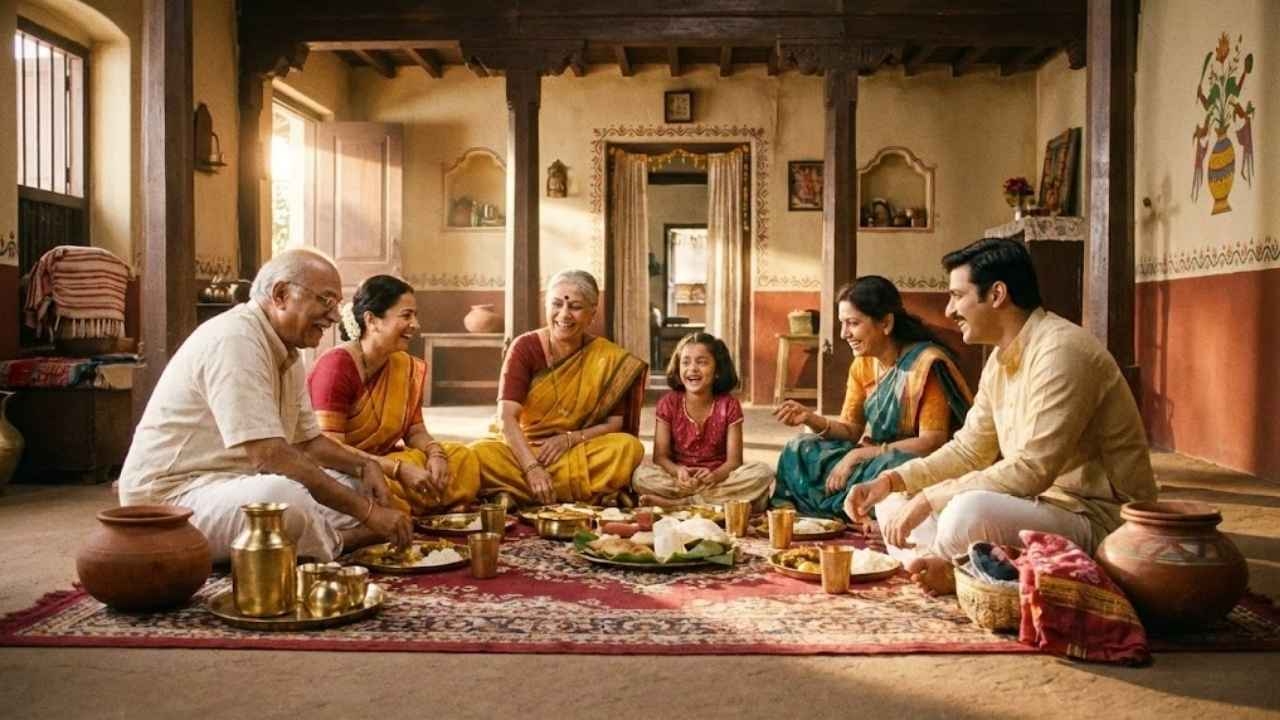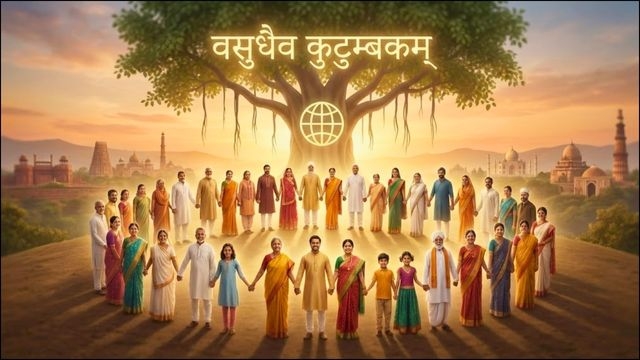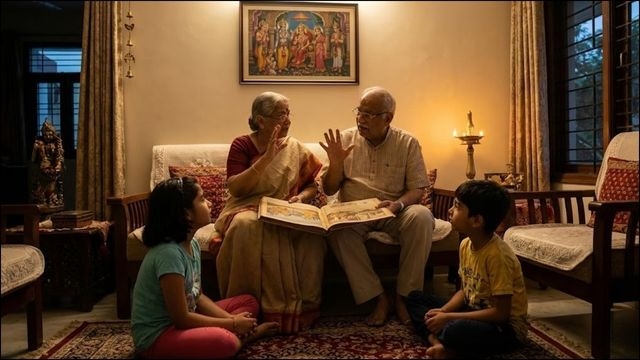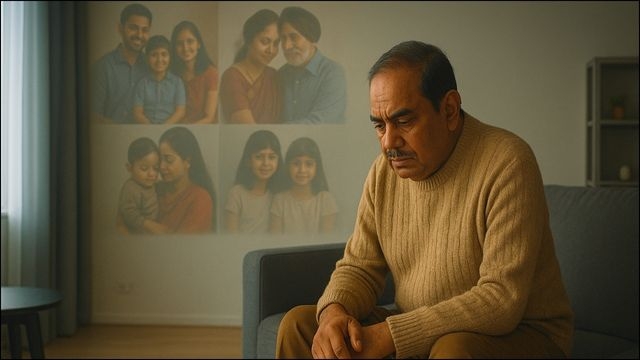The Family Institution: Bharat's Unique Social Foundation
24 Nov 2025 18:28:42

The family stands as humanity's oldest and most enduring social institution. It serves as the primary base for transmitting values, establishing social order, and forging national identity across civilisations. Yet this foundational structure now faces unprecedented pressures from competing global ideologies. Capitalist consumerism commodifies relationships and fragments collective bonds, while communist thought views the family as an obstacle to revolutionary transformation. For Bharat, where the family has historically functioned not merely as a domestic unit but as the cornerstone of social cohesion and national integration, understanding these threats and articulating an alternative model becomes essential for preserving cultural continuity and national unity.
The Traditional Indian Family: Structure and Values
The joint family system represents Bharat's traditional ideal as a multi-generational household where three or four generations live together under one roof, sharing resources, responsibilities, and life experiences. This structure follows principles of collectivism that promote social cohesion and interdependence rather than Western individualism. It creates families that are strong, stable, close, resilient, and enduring, with a focus on family integrity, loyalty, and unity. These values often require individuals to limit certain pursuits linked to personal privacy or extreme individual choice, which can otherwise result in isolation and harmful loneliness.
Within this system, key values shape both character and social behaviour. Sacrifice emerges as a defining principle. For instance, the rickshaw puller who prioritises his sister's marriage over his own illustrates how family obligations cultivate citizens who naturally think beyond self-interest. Respect for elders positions them not as burdens but as sources of guidance and moral authority, ensuring that wisdom and values move from one generation to the next. Togetherness and consultative decision-making replace unilateral choices, teaching democratic attitudes and conflict resolution skills that are essential for citizenship in diverse societies. The joint family becomes a training ground where children learn tolerance, patience, compromise, and the ability to balance personal needs with collective welfare.
Philosophical and Cultural Underpinnings
Indian philosophy provides profound grounding for the family's centrality through ancient concepts such as Vasudhaiva Kutumbakam, which means the world is one family, found in the Maha Upanishad. This principle expands familial bonds beyond immediate relatives to encompass the entire cosmos, creating a philosophical bridge that elevates family ethics to national and global solidarity.
The Grihastha ashrama, or householder stage, occupies a pivotal position in Hindu thought as the second of four life stages. The Gautama Dharmasutra describes it as the foundation of all the ashramas because householders produce food, wealth, and offspring that sustain society and ensure continuity. During this stage, individuals pursue the four goals of life, known as Purushartha: Dharma, or righteousness; Artha, or wealth; Kama, or desires; and Moksha, or liberation. These combine material prosperity with spiritual development.

Central to the Indian family is Dharma, the principle of duty, righteousness, and natural order. Dharma outlines specific responsibilities for each family member, creating mutual obligations. Parents must nurture and guide their children. Children must respect and care for elders. Husbands provide protection and spiritual guidance. All members work together for family harmony. Vedic texts prescribe four pious obligations, known as rnas, which are debts owed to gods, ancestors, teachers, and fellow beings, along with five daily sacrifices including care for parents, service to the poor, and hospitality toward guests. These practices integrate family life with spiritual and social duties, transforming domestic existence into a sacred undertaking.
Two fundamental ethical principles guide family interactions. Satya, or truthfulness, emphasises honesty and trust, while Ahimsa, or non-violence, extends to emotional and verbal conduct, encouraging kindness and discouraging harsh words. The Vedantic understanding that every family member possesses inherent divinity as a manifestation of universal consciousness fosters deep unity and unconditional love that transcends superficial differences.
Family as Agent of National Unity
The Indian family serves as the primary institution that cultivates social cohesion and collective consciousness. This scales from household to nation and embodies the idea that national integration begins at home. The joint family operates as a microcosm of the larger national family, where principles of love, compassion, and mutual support learned within the family extend to fellow citizens.
This system prepares individuals for participation in Bharat's diverse democracy. Growing up in extended families with multiple generations develops qualities essential for national cohesion. Individuals learn to navigate diversity, accommodate different perspectives, resolve disagreements through consultation rather than unilateral decisions, and prioritise group harmony over personal preference. These are the skills that reflect true democracy in action. The joint family creates a strong bond of unity at an early age, paves the way for social cohesion, and in a broader sense promotes national unity by instilling democratic habits and a collective orientation necessary for unity in diversity.

Families also transmit culture, traditions, language, and national loyalty across generations. Ancient epics such as the Ramayana and Mahabharata, passed down through family storytelling, depict resilience and unity forged within these structures. They inspire individuals to prioritise collective well-being over individual interests. This cultural transmission creates a shared national consciousness. Common stories, values, and worldviews bind diverse populations together. The emphasis on duties to family, ancestors, and society cultivates citizens who see themselves as part of interconnected obligations extending from family to nation.
The joint family provides emotional and social security without requiring state intervention, functioning in many ways as Bharat's first welfare state. It encourages savings for future generations, offers support during crises, cares for the elderly and disabled, and distributes childcare responsibilities. This creates economic stability and reduces the social fragmentation that undermines national solidarity.
Capitalism, Consumerism, and Fragmentation
Capitalism views the joint family as an obstacle to market expansion because families that share resources consume significantly less than fragmented nuclear households. When one joint family divides into four nuclear families, it requires four homes, four complete kitchen sets, four televisions, multiple vehicles, and repeated purchases of countless goods. As one analysis notes, when families break, markets flourish. This is not merely an observation but a deliberate strategy. A society that shares, saves, and consumes collectively is simply not profitable.
This fragmentation has resulted from deliberate cultural engineering. Media portrayed joint families as oppressive places full of conflict while presenting nuclear families as modern, free, and self-made. Television serials perpetuated mother-in-law and daughter-in-law conflicts, usually ending with the message that families should separate. Western consumerism rebranded traditional Indian values as backward, conditioning people to view family bonds as burdens instead of assets.

The consequences have severely damaged social cohesion. Elders became burdens rather than sources of wisdom. Children grew isolated without grandparents' guidance. Relatives became unavailable. Issues that grandmothers once resolved now require paid therapists. Loneliness became a medical condition rather than a sign of social failure. Every problem became a product to buy, every emotion became an app, and every festival became an online transaction. Bharat traded sanskar or values for subscription.
Women now bear disproportionate burdens as they juggle employment with domestic responsibilities that were once shared across joint families. The mutual support network of extended households has been replaced by market-based solutions that enrich corporations while weakening social bonds. Exhaustion from doing everything alone is presented as productivity, while isolation is rebranded as independence and freedom. Scholars describe this situation as a demographic and relational crisis, with fatigue disguised as efficiency and abandonment mistaken for autonomy.
Communism and Ideological Threats
Communist ideology directly opposes Indian family values in several ways. Marx and Engels wrote in The Communist Manifesto that traditional families exist mainly to pass down wealth and property. Marx stated that the present family, the bourgeois family, is based on capital and private gain. They sought to abolish this system because they believed families keep wealthy people wealthy and poor people poor over generations. Engels criticised families as tools that allow men to control property and pass it to their children, calling this situation the world-historic defeat of the female sex.
The connection between property and family is central to communist theory. Engels argued that family structure is dominated entirely by the system of property. Marx declared that the bourgeois family would disappear once capitalism disappeared because the two are inseparable. Remove one and the other collapses.
Marx further stated that the working men have no fatherland, meaning that workers should not feel loyalty to their country or family. He believed family ties prevent workers from recognising their true class interests. His famous slogan, Working Men of All Countries, Unite, places global class solidarity above loyalty to one's own family. Communist ideology expects people to show more loyalty to the working class and the socialist state than to their families.

This worldview clashes sharply with Indian joint family values. Indian families centre around passing land and property from parents to children, maintaining respect for elders, and upholding family hierarchy. Communist ideology encourages dividing family land equally among all children even when division destroys unity and makes agriculture unsustainable. It rejects the religious and social structures that hold extended families together.
Most importantly, communist theory requires the socialist state to control all property and production. This eliminates family-based businesses and support systems. Instead of relying on the family, individuals must depend on government institutions. This changes the way people think, encouraging loyalty to the socialist state rather than to the family.
The Indian Model: A Third Way
The Third Way articulated by Dattopant Thengadi and the philosophy of Integral Humanism developed by Deendayal Upadhyaya present distinctly Indian alternatives to both capitalism and communism. Thengadi asks who should control the means of production: the individual or the state. Capitalism answers by supporting individual control through private property and free markets. Communism answers by supporting state control. The Third Way rejects this entire binary.
Integral Humanism regards the family and local community as the fundamental units of society, believing that these structures play crucial roles in nurturing individuals and preserving cultural values. This positions the family as the irreducible social unit. It contradicts both capitalist individualism and communist collectivism.
The Indian model emphasises dharma-centred development that harmonises personal freedom, social welfare, and spiritual values. As Deendayal Upadhyaya warned, a lack of material wealth can hinder progress, yet an obsession with it can also be harmful. Material wealth should serve righteous conduct, not become the ultimate goal. Rather than capitalism's wage-dependent workers or communism's state-controlled economy, the model supports an ever-growing self-employment sector based on family enterprises, small-scale industries, and agriculture. This aligns with traditional Indian production patterns where families controlled their own economic activities.
The principle of Antyodaya, or upliftment of the last person, distinguishes this model from both capitalist trickle-down economics and communist forced equality. It begins development with the most marginalised while sustaining organic social structures. This reflects joint family ethics where the strong support the vulnerable.
The model focuses on labour-intensive work that involves many people rather than machines, and places value on agriculture. This allows families to stay together rather than move away for specialised jobs that weaken family bonds. Society functions best when people perform their duties with respect for others and a sense of shared responsibility. An important principle guides this idea. The more respected and powerful a person is, the more they should contribute to society and the less they should consume. This creates natural redistribution of wealth without government coercion.
This approach believes in transforming people's mindset first, followed by economic structures. Capitalism assumes that society benefits when individuals pursue their own interests. Communism assumes that government control produces equality. The Indian model differs fundamentally. It holds that when people follow dharma and remain connected to their families, they naturally create fair and prosperous communities without the need for selfishness or state force.
Contemporary Challenges and Transformations
Urbanisation, migration, and economic necessity have challenged traditional joint families. Geographic mobility for education and employment separates generations. Economic pressures require dual incomes. Changing gender roles create new expectations. Legal changes, such as amendments to the Hindu Succession Act, influence property transmission. The shift towards nuclear families brings consequences. These include the loss of elderly support systems, increased childcare burdens, children growing up without the wisdom of grandparents, weakened cultural transmission, and reduced economic resilience.
These transformations risk undermining the very structures that have sustained Indian national unity. When capitalism fragments families into competitive individual consumers and communism subordinates family to socialist authority, both eliminate the mediating institution between the individual and the nation that cultivates social cohesion. The sacrifice-oriented mentality essential for national solidarity weakens when replaced by either capitalist individualism or communist socialism.
Balancing Tradition and Modernity
The challenge is not to discard the joint family in pursuit of economic growth but to adapt traditional structures to contemporary needs while preserving core principles. Even when physical proximity is difficult, families can remain bound by the eternal values of love, brotherhood, and sacrifice. The essence of dharma, respect for elders, and the nurturing of children remain universal principles that can thrive within nuclear families and modern lifestyles.
Modern initiatives such as Ek Bharat Shreshtha Bharat apply family-based principles of emotional bonding and mutual understanding to strengthen ties between states. They treat different regions as members of one national family and transform national integration from a ceremonial observance into a continuous people's movement. Technology can support extended family connections across distances. Workplaces can accommodate family responsibilities. The education system can reinforce family values. Policy can encourage multi-generational living arrangements.
The National Education Policy 2020 explicitly incorporates Vasudhaiva Kutumbakam to promote global citizenship alongside patriotism, recognising that family-based values provide the foundations for both national unity and international cooperation. This demonstrates how ancient ideas remain relevant for addressing modern challenges, offering what nuclear households and welfare states often cannot provide, which is the thicker bonds that make joint families work within frameworks that respect both individual dignity and collective duty.
Conclusion
The family institution serves as the root of Indian social and national unity. It functions not merely as a private domestic arrangement but as the sacred foundation of social order, the training ground for democratic citizenship, and the indispensable unit linking individuals to larger communities, and ultimately to the cosmos. The idea of Vasudhaiva Kutumbakam, the world as one family, provides the philosophical bridge that elevates familial bonds to national and global solidarity.
As Bharat modernises and interacts with global systems, it must consciously choose between competing visions. Capitalist fragmentation turns citizens into isolated consumers. Communist ideology subordinates families to state control. The Indian civilisational model positions the family as the fundamental unit of both personal development and collective welfare. Protecting and revitalising family structures is not a retreat into traditionalism but a strategic civilisational choice. It preserves the institutional foundation that enables economic decentralisation, provides social welfare without bureaucratic machinery, ensures cultural continuity, and cultivates a shared sense of duty that is essential for unity in a diverse society.
The Indian family system offers a powerful alternative to Western ideologies. It balances material progress with spiritual values, personal dignity with collective responsibility, and economic development with social cohesion. This model is relevant in an era that seeks sustainable and inclusive solutions. It provides an alternative paradigm to the unsuccessful experiments found in both unrestrained capitalism and authoritarian communism. By strengthening family-centred approaches, Bharat can contribute meaningfully to global discussions on social cohesion and progress. It can demonstrate that modernity does not require abandoning long-standing values but can emerge through adapting them thoughtfully to contemporary life.
The Indian family system can serve as an inspirational model for the world. It shows that economic advancement, technological progress, and global engagement can work in harmony with strong family bonds, intergenerational living, collective consciousness, and dharmic values. Bharat's future social cohesion and national unity depend on recognising that protecting the family institution is inseparable from protecting civilisational identity and democratic health. The family is not a relic of the past but the foundation for a distinctly Indian modernity.
Article by

Aadarsh Gupta
Young Researcher